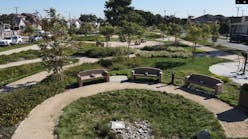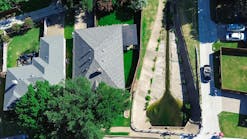Worry-Free Monitoring
About the author: Patrick Chavez is storm water quality engineer for the Albuquerque Metropolitan Arroyo Flood Control Agency. Chavez can be reached at [email protected].
In the early years of its permit history, the Albuquerque Metropolitan Arroyo Flood Control Agency (AMAFCA) operated with a typical MS4 Phase I individual permit that included Minimum Control Measures along with best management practices to enhance water quality including:
- Public education and outreach;
- Public participation and involvement;
- Illicit discharge detection and elimination;
- Construction site runoff control;
- Post-construction runoff control; and
- Pollution prevention/good housekeeping.
Monitoring was conducted under permit compliance and in support of MS4 operations. The conventional NPDES permitting approach provided little consideration of upstream sources except as background concentrations of a pollutant. Often, attainment of water quality standards and other water quality goals was independent of addressing upstream pollutant contributions. The limited data provided by grab sampling made it difficult to determine whether BMPs were effective in supporting water quality standards defined by the U.S. Environmental Protection Agency (EPA).
Watershed-Based Permit
In 2009, at the request of EPA, the National Research Council (NRC) published a report titled, “Urban Stormwater Management in the United States.” NRC determined the framework for addressing sewage and industrial waste within the Clean Water Act was not well suited to the more difficult problem of storm water discharges, and recommended EPA make fundamental changes in the current management of storm water, including switching to a
watershed-based permitting (WBP) approach.
NRC suggested EPA create a pilot program to explore the complexities of WBP. Some of the goals included implementing mechanisms to better tailor storm water management plans and permits to meet the needs and conditions of the selected watersheds. The pilots also would document efficiencies to be gained by implementing certain elements of the storm water program (e.g., education, outreach and monitoring).
EPA selected three pilot areas to explore WBP concepts for storm water management. The Middle Rio Grande (MRG) valley was chosen because of existing water quality impairment in the Rio Grande and the opportunity to work on the challenges of permitting unique to arid and semi-arid parts of the country.
Permit Requirements
The permit requires that discharges not cause or contribute to a violation of an applicable numeric or narrative surface water quality standard. It also requires AMAFCA to control the discharges of pollutant(s) of concern to impaired waters and waters with approved total maximum daily loads.
Sampling of discharges resulting from storm events at upstream and downstream locations is required. Permittees are required to sample for total suspended solids, total dissolved solids, chemical oxygen demand, biochemical oxygen demand, dissolved oxygen (DO), oil and grease, E. coli, pH, total kjeldahl nitrogen, nitrate plus nitrite, dissolved phosphorus, total ammonia plus organic nitrogen, total phosphorus, polychlorinated biphenyls, and gross alpha.
Excessive levels of pollutants discharged during dry weather to the MS4 must be identified, investigated and addressed within the contributing jurisdiction. As a Class A Permittee, AMAFCA also is responsible for monitoring storm water discharges from Type 1 and 2 industrial facilities that discharge located within their jurisdiction.
One or more of the minimum measures can be implemented within a given MS4 by an entity other than the discharger, provided the other entity agrees to implement the control measure on behalf of the MS4, and that the proposed measures are as stringent as those required in the corresponding MS4 permit.
Storm water sampling may be conducted at outfalls, internal sampling stations and/or in-stream monitoring locations. Permittees may choose either an individual or cooperative monitoring program.
There is incentive in the permit to participate in a cooperative sampling program that includes financial contribution by all participating entities. Cost is dependent on the number of entities participating.
Lessons Learned
In support of its storm water monitoring program, AMAFCA received five In-Situ TROLL 9500 multiparameter instruments from the U.S. Geological Survey (USGS). The units had internal batteries and onboard data logging, which made them ideal for continuous monitoring. They were deployed at five key sites along the MRG within the permit boundaries, collecting pH, oxidation reduction potential, DO, temperature, turbidity and depth.
As part of environmental conditions for the permit, the U.S. Fish & Wildlife Service requires AMAFCA to record DO and temperature readings every 15 minutes. The data are used to calculate and report conditions during a storm event. The early design of the instrument lacked a sleep mode, so the units were continuously on. Batteries lasted only two to four weeks. If the batteries died over the weekend, DO data at the given location were lost, causing AMAFCA to be out of compliance with the biologic component of the permit.
Ongoing battery issues resulted in lost data and an inability to reliably comply with reporting requirements. Lack of real-time visibility to sensor status, especially the depth of water over the sonde, resulted in added uncertainty. The storm water team had to make frequent site visits to conduct maintenance on the units. The system’s maintenance and resource requirements proved to be a burden on the agency.
Phasing in New Technology
For permit compliance, the MRG cooperative has two monitoring points, located north and south of the urbanized portion of the river. Other more arid areas within the watershed are not monitored due to their flashy nature; none of them are connected to the river continuously.
As the new WBP was launched, the AMAFCA team decided to leverage the benefits of collective funding and the reduced number of monitoring sites required for compliance to increase the quantity, quality and availability of data. A decision was made to upgrade the old sondes in phases.
In-Situ released its Tube telemetry system and Aqua TROLL 600 multiparameter water quality sonde. Improvements were made to the sonde, including extended battery life, redesigned sensors and an antifouling system. The telemetry system includes a lithium-ion battery that provides a supplemental power source for both the TROLL 9500 and the Aqua TROLL 600. This was an important consideration and improved the availability of DO data because of the reliable power source.
The agency added a Tube to one TROLL 9500 site, and replaced a TROLL 9500 at another site with an Aqua TROLL 600 and Tube. The newer sondes and the Tubes are non-vented, which eliminates the risk of flooding during periods of high runoff, which was problematic in earlier Tubes. In the past, because AMAFCA did not know what the river was doing, it was eyeballing levels using USGS stream gage data. Using In-Situ’s cloud-based data management software, HydroVu, AMAFCA knows exactly what the depth is over every sensor at any given time.
This allowed the agency to stream data from the two monitoring points in near-real time to the office. At the two sampling points, the Aqua TROLL 600 continuously collects temperature, pH, DO, conductivity, turbidity, level and depth. Data is uploaded to HydroVu Data Services, a cloud-based data management system, via the telemetry systems.
The monitoring systems provide continuous monitoring at compliance sites. While the permit still requires collection of seven grab samples, having access to the data in real time gives AMAFCA the ability to tell if something is not right.
Program Growth & Leadership
As AMAFCA gains experience with the new technologies, it improves the system to ensure the best possible performance from its sites. In its deployment, it chose to remove the end cap of the Aqua TROLL 600 restrictor, a common practice in rivers with high sediment loads to help minimize sediment fouling.
AMAFCA has been tracking task order time and materials with consultants at each site over the years. As it updates each site to the new telemetry and multiparameter sonde paradigm, it sees a reduction in the time required to manage each site and a resulting return on investment. That return on investment allows AMAFCA to fund further growth of the program.






